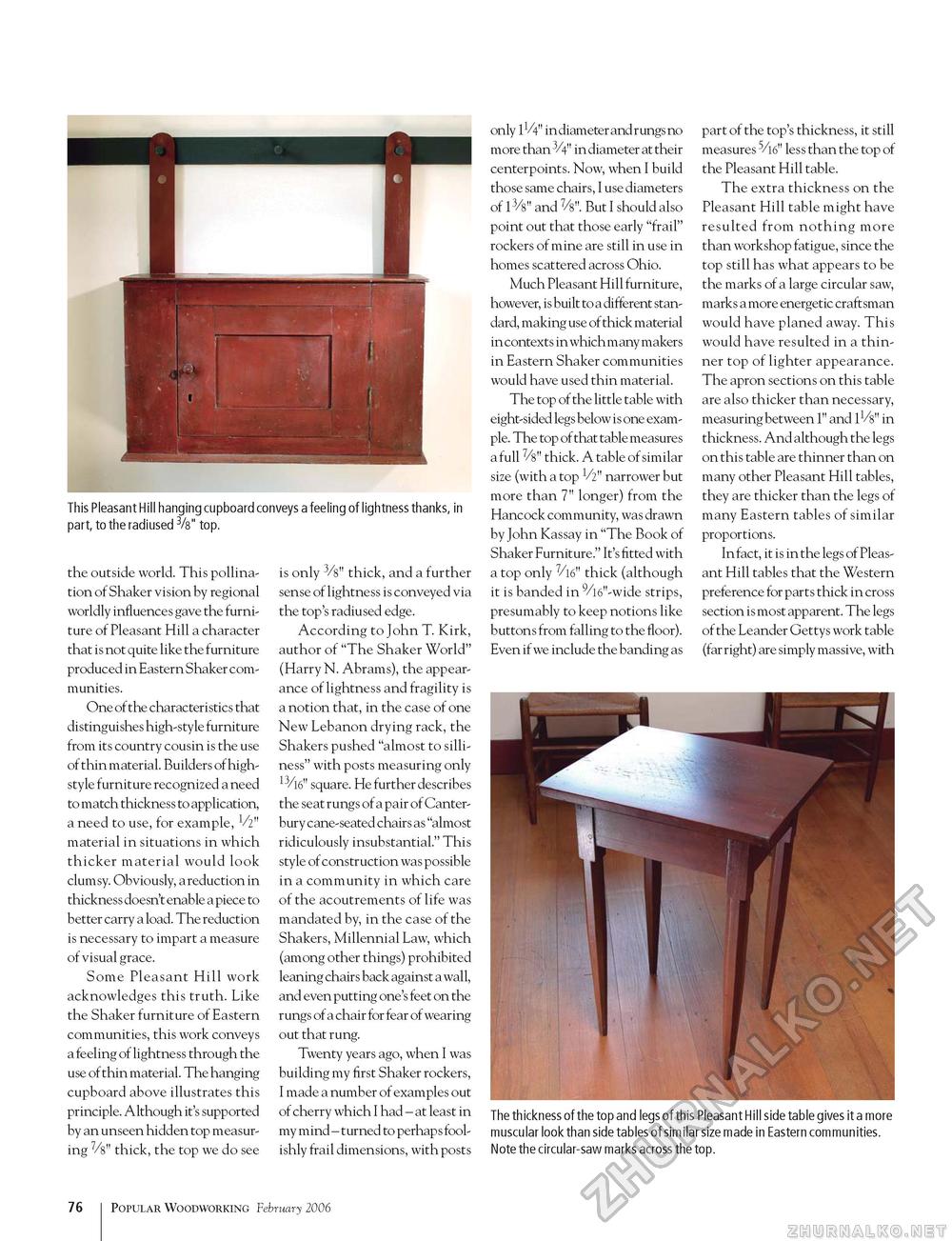Popular Woodworking 2006-02 № 153, страница 75
the outside world. This pollination of Shaker vision by regional worldly influences gave the furniture of Pleasant Hill a character that is not quite like the furniture produced in Eastern Shaker communities. One of the characteristics that distinguishes high-style furniture from its country cousin is the use of thin material. Builders of high-style furniture recognized a need to match thickness to application, a need to use, for example, VZ" material in situations in which thicker material would look clumsy. Obviously, a reduction in thickness doesn't enable a piece to better carry a load. The reduction is necessary to impart a measure of visual grace. Some Pleasant Hill work acknowledges this truth. Like the Shaker furniture of Eastern communities, this work conveys a feeling of lightness through the use of thin material. The hanging cupboard above illustrates this principle. Although it's supported by an unseen hidden top measuring 7/8" thick, the top we do see is only 3/s" thick, and a further sense of lightness is conveyed via the top's radiused edge. According to John T. Kirk, author of "The Shaker World" (Harry N. Abrams), the appearance of lightness and fragility is a notion that, in the case of one New Lebanon drying rack, the Shakers pushed "almost to silliness" with posts measuring only square. He further describes the seat rungs of a pair of Canterbury cane-seated chairs as "almost ridiculously insubstantial." This style of construction was possible in a community in which care of the acoutrements of life was mandated by, in the case of the Shakers, Millennial Law, which (among other things) prohibited leaning chairs back against a wall, and even putting one's feet on the rungs of a chair for fear of wearing out that rung. Twenty years ago, when I was building my first Shaker rockers, I made a number of examples out of cherry which I had - at least in my mind - turned to perhap s foolishly frail dimensions, with posts only 11/4" in diameter and rungs no more than 3/4" in diameter at their centerpoints. Now, when I build those same chairs, I use diameters of 13/s" and 7/8". But I should also point out that those early "frail" rockers of mine are still in use in homes scattered across Ohio. Much Pleasant Hill furniture, however, is built to a different standard, making use of thick material in contexts in which many makers in Eastern Shaker communities would have used thin material. The top of the little table with eight-sided legs below is one example. The top of that table measures a full 7/8" thick. A table of similar size (with a top V2" narrower but more than 7" longer) from the Hancock community, was drawn by John Kassay in "The Book of Shaker Furniture." It's fitted with a top only 7/16" thick (although it is banded in 9/16"-wide strips, presumably to keep notions like buttons from falling to the floor). Even if we include the banding as part of the top's thickness, it still measures 5/16" less than the top of the Pleasant Hill table. The extra thickness on the Pleasant Hill table might have resulted from nothing more than workshop fatigue, since the top still has what appears to be the marks of a large circular saw, marks a more energetic craftsman would have planed away. This would have resulted in a thinner top of lighter appearance. The apron sections on this table are also thicker than necessary, measuring between 1" and 11/8" in thickness. And although the legs on this table are thinner than on many other Pleasant Hill tables, they are thicker than the legs of many Eastern tables of similar proportions. In fact, it is in the legs of Pleasant Hill tables that the Western preference for parts thick in cross section is most apparent. The legs of the Leander Gettys work table (far right) are simply massive, with The thickness of the top and legs of this Pleasant Hill side table gives it a more muscular look than side tables of similar size made in Eastern communities. Note the circular-saw marks across the top. 76 102 Popular Woodworking February 2006 |








